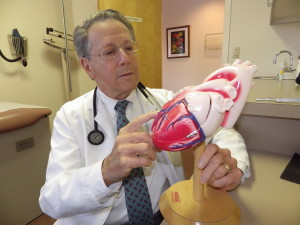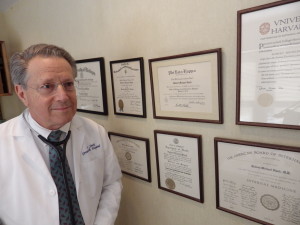Cardiologist Robert Stark, 65 and a Greenwich resident, recently addressed a symposium at Temple University in Philadelphia. His topic ”” doctor burnout ”” proved popular; 200 M.D.s attended.
He called the problem “underaddressed or just beginning to be addressed.” His eye-opening metrics include the female M.D. suicide rate, which is 5.7 times higher than for other women, and a survey indicating 37 percent of all physicians were experiencing “severe” stress and/or burnout.
Stark treads, he said, on delicate ground. “I don”™t want people to put off going to their doctor fearing he or she might have stress,” he said. “But the problem should not be ignored.”
At Temple, the feedback bore out his thesis that the problem is widespread.

“A doctor came up to me afterward to address the suggestion that talking more with colleagues is part of the cure,” he said, seated recently in his Greenwich office. “This doctor said, ”˜My colleagues are more burned out than I am. It drags me more down to talk to them, so I stay away.”™”
Stark”™s appraisal of the conversation: “This is terrible.”
Stark diagnoses and treats valvular heart disease, high cholesterol, high blood pressure and coronary heart disease via medication and lifestyle alteration. He is medical director of the cardiac prevention program at Greenwich Hospital/Yale New Haven Health and a consulting doctor for Minneapolis-based Physician Wellness Services, which conducted the physician health survey on suicides (1 in 16 doctors has contemplated it) and burning out. The survey also revealed 62 percent of doctors see stresses heading in the wrong direction: up.
Stark and Physician Wellness Services promote the need to engage in “mindfulness,” which is no more complex (nor easily achievable) than forgetting all else and living in the moment. Its practitioners down through the ages have included mystics of many faiths and even Yoda on the big screen. With mindfulness, a doctor”™s head is in the room and not on yesterday”™s procedure or tomorrow”™s results, despite the fact life and death could be at stake.
“I”™ve tried it and it does work,” Stark said. He noted Physician Wellness Services has embraced it as a way to improve doctor performance. “They preach being in the moment, appreciating the moment. Try not to live in the past or be apprehensive about the future. It should be a part of medical school training; it prepares a doctor with resiliency.”

Mindfulness arrives as medical school is more collegial than when Stark attended in the 1960s. Infamously long intern hours are now less, as well.
But the tendency of doctors not to seek help for stress and burnout remains virtually unchanged. Stark, who asks his colleagues to seek each other out ”” even skirting the mental health system if they so desire ”” and who considers himself “an accessible, approachable man,” has been approached by exactly two peers across a lifetime in medicine.
“Most peers grin and bear it and they push on,” he said. “They maintain the status quo, but it”™s not right for the physician”™s health and well-being. Stress and burnout can affect their interest and their presence in their job.”
The burnout problem, while widespread, also comes with the turf. The profession requires great determination and no small amount of smarts, attracting a cohort not used to defeat. In Stark”™s words: “They tend to be compulsive, driven, goal-oriented, with an exaggerated sense of responsibility.”
The upshot, as Stark said, “When things go wrong, and things will go wrong through no one person”™s fault ”” there may have been a whole team involved ”” the feeling is one of guilt for not assimilating every last thing. This is partly a feature of those who go into medicine.”
Stark, the son of a chemist, personally did well in organic chemistry as an undergraduate majoring in cellular biology at the University of Michigan. The difficult course remains a convenient bellwether for medical school admission coast to coast. “It”™s always described as a bear,” he said. “Perhaps a B in organic should not be a disqualifier for admission to medical school. Organic weeds people out and it shouldn”™t. It”™s a test to memorize facts; there”™s more to medicine than memorizing facts.”
An improvement would see greater linkage of undergraduate chemistry and physics with clinical correlations, he said.
Stark witnessed different hours as a medical student at Harvard Medical School than he had seen as an undergraduate and, he said, he saw burnout immediately. “This first year was tough,” he said, expounding upon the stress levels. “The first thing I noticed was how tremendously hard all the people were working. They were really working hard.”
And the pressure increased. “By the third year, doing rotations on the wards proved a real eye-opener,” he said. “Interns and resident worked insane hours.” After overnight shifts, details of the previous night were reviewed. “These were not benign inquiries. The doctor came in; he was fully rested. The grilling was intense, not just on a patient but on any related topic. It was designed to stress.” Stark, who never had to pull an all-nighter to pass organic chem, discovered a different environment at Mass General, Harvard”™s primary teaching hospital. “It would be 2 or 3 a.m.; I”™d be tired but I had all this work to do for the a.m. rounds. It was my first exposure to all-nighters.”
As undergraduate days would come to appear simple, so Harvard Medical School would become an also-ran in the stress arena. “It was at University of Pennsylvania Hospital” ”” where he would complete training in internal medicine and cardiology ”” “where I really learned about burnout, working 80, 90, 100 hours per week.” His assessment: “An iron-man philosophy is promulgated that nothing harms us and we can accomplish anything.”
A mid-1980s lawsuit involving an exhausted medical intern has led to limits on training hours for those who would be doctors.
The majority ”” more than 86 percent ”” of U.S. physicians are moderately to severely stressed or burned out on an average day, according to Physician Wellness Services.
That is the sort of arresting number that prompted a question from Stark”™s Temple University audience: “How do we know all this burnout is inherent in physicians and is not the result of the medical system?”
It is, Stark acknowledged, a changing health landscape. He also said change is a constant and that, regardless, if it is producing too much stress it must be addressed.
“Most stressed-out doctors feel they are totally alone,” Stark said. “My advice is to reach out to someone close who you trust ”” it need not be a mental health specialist ”” and be open to advice, whether practical or referral. The message is that doctors should take care of each other more than they are.”




















